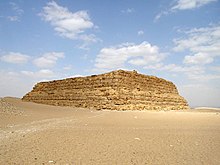
Back Mastaba Afrikaans مصطبة (آثار) Arabic مصطبه ARZ Mastaba Azerbaijani Мастаба Byelorussian Мастаба Bulgarian Mastaba Breton Mastaba BS Mastaba Catalan Mastaba Czech

A mastaba (/ˈmæstəbə/ MASS-tə-bə,[1] /ˈmɑːstɑːbɑː/ MAHSS-tah-bah or /mɑːˈstɑːbɑː/ mahss-TAH-bah), also mastabah or mastabat) is a type of ancient Egyptian tomb in the form of a flat-roofed, rectangular structure with inward sloping sides, constructed out of mudbricks or limestone. These edifices marked the burial sites of many eminent Egyptians during Egypt's Early Dynastic Period and Old Kingdom. Non-royal use of mastabas continued for over a thousand years.
The word mastaba comes from the Arabic word مصطبة (maṣṭaba) "stone bench".[2] The Ancient Egyptian name was pr-Djt, meaning "house of stability", "house of eternity", or "eternal house".
- ^ "Mastaba: definition". Collins Dictionary. n.d. Retrieved 23 October 2014.
- ^ "Mastaba Tomb of Perneb". Met Museum. Retrieved 22 October 2016.
© MMXXIII Rich X Search. We shall prevail. All rights reserved. Rich X Search